Localizer Approaches
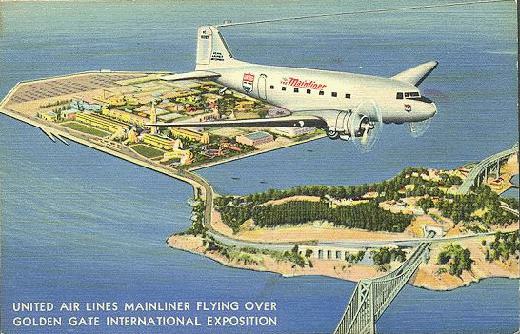
1939. Doesn't this remind you of a simpler time? No instrument approach needed here. Sorry, no prizes for guessing the type aircraft.
You've had plenty to read so far, so we'll get right into some flights. All flights in this section end with Localizer Approaches, with no vertical guidance information provided. Thus they all are non-precision approaches, and Minimum Descent Altitudes, MDAs, will apply.
Some pilots call non-precision approaches "Dive and Drive"—"Dive" to the MDA and then you're so low that you feel you could almost "Drive" to the runway.
Five practice flights provide lots of variety on types of Localizer approaches.
* * *
Flying the Localizer
Most of the skills learned when flying VOR approaches are applicable to Localizer approaches.
- Turn towards the needle to correct for drift—except for a Back Course approach when you do the opposite and turn away from the needle to correct for drift.
- Don't chase the needle.
- Establish the proper Wind Correction Angle very early in the approach.
- Stabilize the approach so that only power changes are needed for altitude changes.
The biggest difference, of course, is the four-times increase in sensitivity when tracking a localizer. Off course by one degree is a two-dot deflection on the Indicator gauge. A half-degree misalignment is one dot.
How do you correct a heading that is misaligned by one-half degree? You "kick it over." Yes, that means rudder pedals. And you kick the pedal on the side that you want to turn. Right turn. Right pedal. You simply don't bank a plane when you want to make a 1° heading adjustment.
One of the joys of flying the MS flight simulators are that the aircraft are generally very stable on heading. It's too bad the same can't be said for altitude stability. So once you have established your heading, your aircraft is likely to stay where you want it all the way down the pipe to the runway.
A joystick is the least satisfactory control when flying a localizer or ILS. It is very difficult to make small changes with a joystick. They are super in combat situations when you want to roll out of a tough situation, but not ideal for holding the localizer.
A yoke is the next step up from a joystick. It's easier to make small heading corrections with it than a joystick. The realism is more satisfying, too.
And, as mentioned, rudder pedals with a yoke is the best possible choice. Now you have the same control over your flight that a pilot flying the big iron has (and the same control as one who flies the small iron, too).
Something to think about when your tax refund arrives and you're puzzled about how to spend it.
* * *
The first flight is from Newburgh, N.Y., KSWF, to the Essex Co. airport, KCDW, in Caldwell, N.J.
Localizer approaches are very similar to VOR approaches with a few slight differences. The most noticeable will be the increased sensitivity of the needle on the localizer indicator. As already mentioned, it is four times as sensitive as when the Nav receiver is tuned to a VOR signal.
Also recall that the OBS setting has no impact on the needle. So get into the habit of setting the OBS to the localizer approach course as a reminder of where you are going. It will be one less thing to write down or remember and it is always in front of you.
* * *
Stewart Int'l airport, Newburgh, N.Y. to Essex Co. airport, Caldwell, N.J.
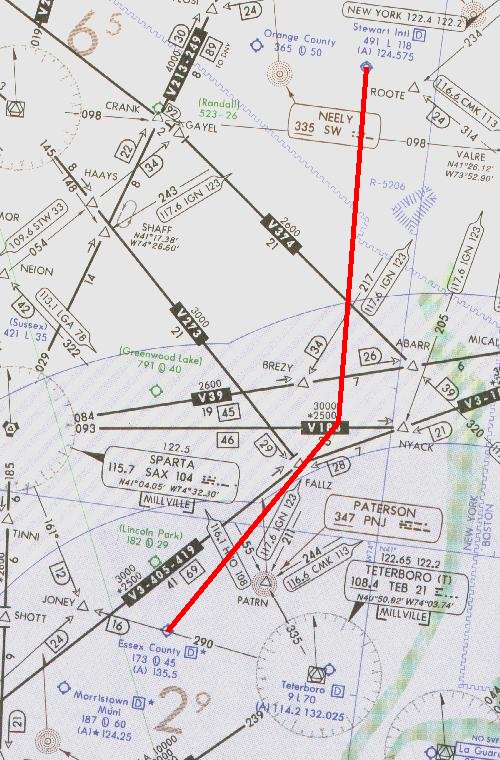
Stewart Int'l., Newburgh, NY., to Caldwell, N.J. with localizer approach to Runway 22. Click the image to access the complete flight-information package.
This first flight is easy and enjoyable. The flight begins at Stewart Int'l airport, KSWF, in Newburgh, N.Y. with a destination of Essex Co. airport, KCDW, in Caldwell, N.J. The localizer approach is to Runway 22. Click on the image above to download the flight-information package, swf-cdw.zip.
The zip-file includes the IFR chart, the approach plate for LOC Rwy 22 at Caldwell, and this text description of the flight.
We proceed south-bound from Stewart, tracking to the Teterboro VOR, but intersect the localizer to Caldwell's Runway 22., before reaching Teterboro. We turn right to track inbound to Caldwell with a straight-in landing to Runway 22. We must pass a VOR intersection after the FAF before descending below 800 ft.
As usual, do nothing until you have gone through the step-by-step details of the flight with this text and your charts. Only by doing this will you both understand the purpose of each step, but you will visualize them in your mind, a critical part of instrument flight.

NOTE: Fly the Instrument Approach portion with your Nav-2 Receiver for better needle visibility.
- Set the flight simulator weather conditions to 1100 ft overcast, cloud tops at 10,000 ft., and two miles visibility. The wind is calm.
- Move the aircraft to Stewart's Runway 16, airport KSWF, and retract the flaps to 0°.
- Tune the Nav-1 receiver to the Teterboro VOR, 108.4 MHz., ident TEB.
- Set the VOR-1 OBS to the vicinity of 190°. You will center the needle with the OBS after takeoff and track that radial until intercepting Caldwell's localizer. Fly the first leg with Nav-1.
- Tune the Nav-2 receiver to Caldwell's localizer, 109.35 MHz., ident I-CDW.
- Set the VOR-2 OBS to 223°, the localizer track to the runway.
- Reset the timer to zero.
- Takeoff from Runway 16, climbing out with a modest right turn 190°.
- Fly Nav-1. When your VOR-1 comes alive, and warning flags disappear, readjust the OBS as necessary to center the needle. Observe that a TO flag is showing and then ident the VOR, TEB.
- Track that radial to Teterboro. ATC has cleared you to 4000 ft. Climb at 90 kts., then cruise at 110 kts. after reaching your assigned altitude.
- You will intercept Caldwell's Runway 22 localizer before reaching the Teterboro VOR, about 13 min. into the flight.
- Begin your descent to 2000 ft. when the VOR-2 Localizer needle comes alive, i.e., when you can see movement towards the center of the gauge. Descent rate should be no more than 500 to 700 fpm.
- Note from the diagram on the approach plate that the 25 NM MSA is 3000 ft. You will intercept the localizer at about 18 NM from the field, putting you well within the 10 NM safe radius for the Localizer approach. Observe that the safe radius centers on the FAF, some 5 NM before the field. Therefore you can go immediately to the altitudes shown for the approach, which is 2000 ft, until reaching the FAF.
- Ident the localizer before committing to the right turn, I-CDW.
- Fly Nav-2. Turn right to heading 223° on intercept to track inbound to Runway 22.
- Continue your descent to 2000 ft.
- Slow to 75 kts. and drop one notch of flaps.
It's vital to stabilize the approach well before beginning your descent to the MDA.
- Readjust the VOR-1 OBS to 323°—a FROM flag should appear. When that needle centers you are at the FAF for the Runway 22 approach. Monitor its progress to keep appraised of your relative distance to the FAF.
- Maintain 2000 ft. until the FAF.
- The Outer Marker beacon will sound out dashes at the FAF, and the Blue OM light will appear on the marker beacon receiver's indicator.
- At the OM, start your timer and start your descent to the 860 ft. MDA.
- Readjust the VOR-1 OBS to 303°. You may not descend below 800 ft before passing this intersection, even if you have the field firmly in sight.
- Hold your rate of descent between 500 fpm and 700 fpm. Passengers in unpressurized aircraft unaccustomed to flight will be uncomfortable with higher rates of descent.
- Don't chase the needle; it will be very sensitive as you near the runway. Just try to keep it from moving.
- At 75 kts., 4 min., 14 secs. will elapse to fly the 5.3 nm. to the MAP or Runway 22 threshold.
- With two-miles visibility, Runway 22's threshold or approach lights should become visible in 2 min., 38 secs.
- Caldwell's field elevation is 173 ft., so you will have a minute and a half to descend 687 ft. for touchdown. Slow the aircraft for a normal landing by reducing power and further lowering the flaps.
- Good job; have a cup of coffee. The Boss said he'd pay for it.
- Flight time: About 25 minutes.
* * *
Manchester, N.H. to Beverly, Mass.
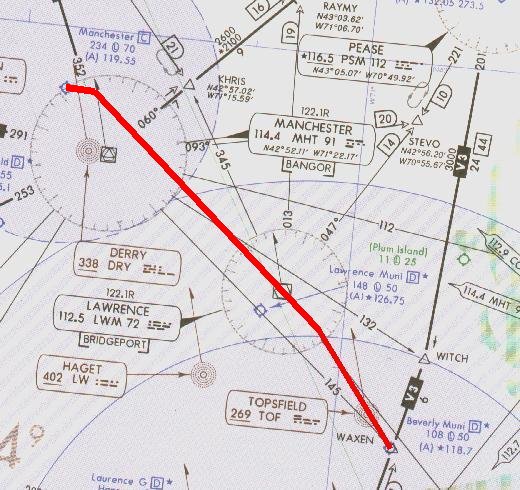
Manchester, N.H. to Beverly, Mass. with localizer approach to Runway 16. Click the image to access the complete flight-information package.
This flight is somewhat shorter than the first flight but a little busier during the final approach. The flight begins at Manchester airport, KMHT, in Manchester, N.H. with a destination of Beverly, Massachusetts, KBVY. The localizer approach is to Runway 16. Click on the image above to download the flight-information package, mht-bvy.zip.
The zip-file includes the IFR chart, the approach plate for LOC Rwy 16 at Beverly, and this text description of the flight.
We proceed south-east bound from Manchester to the Lawrence VOR, then intersect the localizer to Beverly's Runway 16., making a right turn to track inbound to the airport with a straight-in landing to Runway 16. A VOR intersection is the FAF for this approach.
As usual, do nothing until you have gone through the step-by-step details of the flight with this text and your charts. Only by doing this will you both understand the purpose of each step, but you will visualize them in your mind, a critical part of instrument flight.
NOTE: Fly the Instrument Approach portion with your Nav-2 Receiver for better needle visibility.
You'll use your DME to identify the FAF.
- Set the flight simulator weather conditions to 800 ft overcast, cloud tops at 10,000 ft., and two miles visibility. The wind is calm.
- Move the aircraft to Manchester's Runway 17, airport KMHT, and retract the flaps to 0°.
- Tune the Nav-1 receiver to the Lawrence VOR, 112.5 MHz., ident LWM.
- Set the VOR-1 OBS to 145°. Fly the first leg with Nav-2.
- Tune the Nav-2 receiver to Beverly's localizer, 110.5 MHz., ident I-BVY.
- Set the VOR-2 OBS to 157°, the localizer track to the runway.
- Reset the timer to zero.
- Switch your DME to Nav-1 receiver to monitor progress to LWM VOR.
- Fly Nav-1. Takeoff from Runway 17, climbing out with a modest left turn to intercept LWMs 145° radial. A TO flag should appear. Ident the VOR.
- ATC has cleared you to 3000 ft. Climb at 90 kts., then cruise at 110 kts. after reaching your assigned altitude.
- Be alert for station passage at LWM as things will get busy.
- On station passage at LWM, when the FROM flag appears, continue on your 145° heading.
- Begin your descent to 1800 ft.
- Switch your DME to Nav-2 receiver.
- Fly Nav-2. Turn right to 157° as you intercept the Runway 16 localizer.
- Slow to 75 kts. and drop one notch of flaps.
It's vital to stabilize the approach well before beginning your descent to the MDA.
- The FAF is 5.8 DME from KBVY, on Nav-2 .
- Maintain 1800 ft. until the FAF.
- At 5.8 DME, the FAF, start your timer and start your descent to the 580 ft. MDA.
- Hold your rate of descent between 500 fpm and 700 fpm.
- Don't chase the needle; it will be very sensitive as you near the runway. Just try to keep it from moving.
- At 75 kts., 4 min., 00 secs. will elapse to fly the 5.0 nm. to the MAP or Runway 16 threshold.
- With two-miles visibility, Runway 16's threshold or approach lights should become visible in 2 min., 24 secs.
- Beverly's field elevation is 108 ft., so you will have about one and a half minutes to descend 472 ft. for touchdown. Slow the aircraft for a normal landing by reducing power and further lowering the flaps.
- Safe landing, the runway will be wet.
- Flight time: About 19 minutes.
* * *
LDA Approach vs. Localizer Approach ... Is there any difference?
Not much, actually. If you've thumbed your way through an FAA volume of instrument approach plates you'll have noticed an occasional heading such as LDA Rwy 2, and the like. Although they're not common, you may encounter a Localizer-type Directional Aid in your Flight-Simulator travels.
If you stay on course with a conventional localizer approach it will roll you down the centerline of the runway. That's why Cat II and Cat III ILS approaches are possible.
The LDA is the same as a localizer, but off-set from the runway heading. It provides course guidance down to a point from which you can proceed to the airport by visual references. Terrain features generally force the installation of an LDA approach system; it's the skyscraper, or 1000-ft. TV tower, or granite hill on the normal approach path that prevents using the conventional localizer.
Chester, Connecticut to Hartford, Connecticut
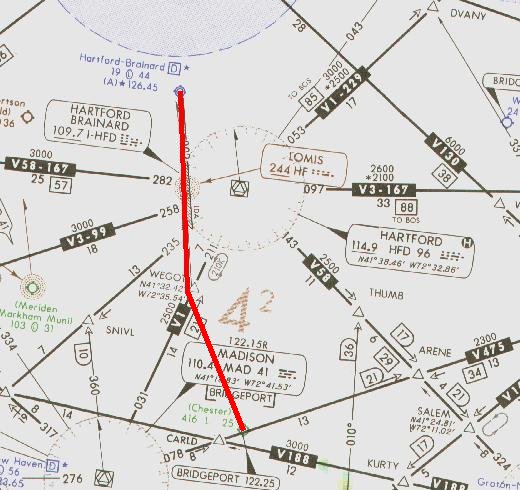
Chester, Conn. to Hartford, Conn. with LDA approach to Runway 2. Click the image to access the complete flight-information package.
This next flight culminates with an LDA approach. Think of it as one more way to keep final approaches from becoming too boring. It's very short and begins at the Chester, Connecticut, airport, 3B9, where you earlier began a flight leading to a VOR approach. We're heading in a different direction this time, to the Hartford-Brainard airport, KHFD, in Hartford, Connecticut.
The LDA approach at Brainard is to Runway 2. Click on the image above to download the flight-information package, chstr-hfd.zip. The zip-file includes the IFR chart, the approach plate for LDA Rwy 2 at Hartford-Brainard, and this text description of the flight.
The flight could hardly be simpler. We proceed northwest, make an easy intercept of the Runway 2 localizer into Brainard. After the FAF we cannot descend below the MDA until passing the Danns intersection, even if the field is in sight. Assume that this flight is under radar control, allowing the direct route to an intercept of the localizer.
As usual, do nothing until you have gone through the step-by-step details of the flight with this text and your charts. Only by doing this will you both understand the purpose of each step, but you will visualize them in your mind, a critical part of instrument flight.
Remember, this is an LDA approach, Localizer-type Directional Aid, and the approach path is not lined up with the runway. A right turn is necessary upon reaching the runway to land. Going straight, without the turn, will bring you down onto the taxiway and into the control tower, a rather unsatisfactory ending to a good IFR approach.
NOTE: Fly the Instrument Approach portion with your Nav-2 Receiver for better needle visibility.
- Set the flight simulator weather conditions to 900 ft overcast, cloud tops at 10,000 ft., and two miles visibility. The wind is calm.
- Move the aircraft to Chester's Runway 35, airport 3B9, and retract the flaps to 0°.
- Tune the Nav-1 receiver to the Hartford VOR, 114.9 MHz., ident HFD.
- Set the VOR-1 OBS to 278°.
- Tune the Nav-2 receiver to Brainard's Runway 2 Localizer, 109.7 MHz., ident I-HFD.
- Set the VOR-2 OBS to 002°. The Runway 2 heading is 23°, so anticipate a 21° right turn on arrival.
- Reset the timer to zero.
- Fly Nav-2. Takeoff from Runway 35, climbing out with a modest 10° left turn to a 345° heading to insure intercepting the localizer at a comfortable distance from the FAF.
- ATC has cleared you to 3000 ft. Climb at 90 kts., then cruise at 110 kts. after reaching your assigned altitude.
- Ident both the localizer, I-HFD, and the VOR, HFD. A FROM flag should be showing on the HFD VOR.
- On intercept of the localizer, turn right to 002° to track it inbound.
- Descend to 2200 ft.
- Slow to 75 kts. and drop one notch of flaps.
It's vital to stabilize the approach well before beginning your descent to the MDA.
- Watch the progress of the VOR-1 needle. When it centers you will be at the FAF.
- Reset the VOR-2 OBS to 023° the runway heading. Maintain 2200 ft. until the FAF.
- When the Outer Marker sounds, and the Blue marker light appears, with the VOR-1 needle centered from the HFD VOR, start your timer and start your descent to the 640 ft. MDA.
- Hold your rate of descent between 500 fpm and 700 fpm.
- Reset the VOR-1 OBS to 323°, the Danns Intersection.
- Don't chase the needle; it will be very sensitive as you near the runway. Just try to keep it from moving.
- Include VOR-1 in your instrument scan; you cannot descend below the MDA until passing Danns Intersection, when this needle centers.
- At 75 kts., 4 min., 43 secs. will elapse to fly the 5.9 nm. to the MAP or Runway 2 threshold.
- With two-miles visibility, Runway 2's threshold or approach lights should become visible in 3 min., 07 secs.
- One more time, this is an LDA approach. Anticipate a 21° right turn to land after sighting the runway.
- Brainard's field elevation is 19 ft., so you will have one and a half minutes to descend 621 ft. for touchdown.
- Slow the aircraft for a normal landing by reducing power and further lowering the flaps.
- The Runway 2 landing threshold is displaced 410 ft. Don't touchdown early.
- Pray that, before your next arrival here, a bulldozer removes what ever terrain features prevented this from being a standard localizer approach.
- Flight time: About 15 minutes.
* * *
Lebanon, New Hampshire to Springfield, Vermont
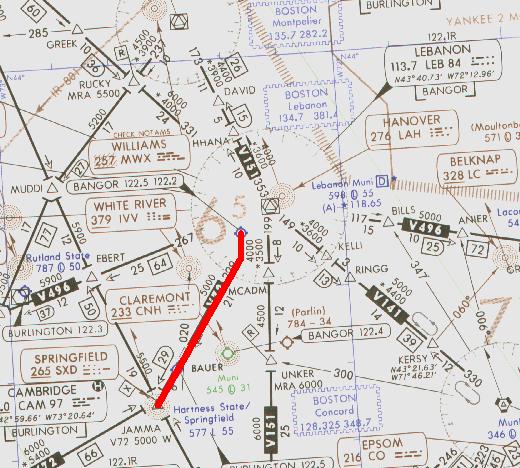
Lebanon Muni airport, Lebanon, N.H. to Springfield, Vt. with a Localizer circling approach to Runway 23. Click the image to access the complete flight-information package.It's time to notch up the excitement a little. This flight has several new aspects: a DME reading determines the FAF, the Localizer back course must be flown to set up the approach, a procedure turn is needed to get turned around, and it all ends with a localizer approach to Runway 5, then circling around to land on Runway 23.
The flight begins at Lebanon Muni airport, KLEB, Lebanon, New Hampshire, with a destination of Hartness State airport, KVSF, Springfield, Vermont. A localizer approach to Runway 5 and circling to land at Runway 23 ends it all. Click on the image above to download the flight-information package, leb-vsf.zip.
The zip-file includes the IFR chart, the approach plate for LOC-A at Springfield, and this text description of the flight.
Recall that if an approach plate name ends in a letter, like LOC-A, rather than a runway number, then a circling approach is required. Looking at Springfield's LOC-A approach plate, you will notice that the localizer takes you right down the throat of Runway 5; a 050° localizer course to Runway 5 which is aligned to 050°. So what's the problem with a straight-in approach to Runway 5?
Your elevation above the runway threshold is the problem. The field elevation is 577 ft. and the MDA is 1660 ft., nearly 1100 ft, above the end of the runway. That's too high to safely descend and land, thus a circling approach is called for.
We proceed south-bound from Lebanon Muni, intercept the 228° radial from Lebanon VOR, intercept Springfield's Localizer and pass over the Springfield airport. We fly outbound on the localizer and enter a standard left procedure turn two minutes after passing the SXD NDB. We return to the airport on the localizer, with SXD NDB the FAF for the approach. Descend to the MDA, circle the airport on sighting it, and land on Runway 23.
As usual, do nothing until you have gone through the step-by-step details of the flight with this text and your charts. Only by doing this will you both understand the purpose of each step, but you will visualize them in your mind, a critical part of instrument flight.
NOTE: Fly the Instrument Approach portion with your Nav-2 Receiver for better needle visibility.
You will also use the DME to establish the FAF.- Set the flight simulator weather conditions to 1900 ft overcast, cloud tops at 10,000 ft., and two miles visibility. The wind is calm.
- Move the aircraft to Lebanon's Runway 18, airport KLEB, and retract the flaps to 0°.
- Tune the Nav-1 receiver to the Lebanon VOR, 113.7 MHz., ident LEB.
- Set the VOR-1 OBS to 228°, the Lebanon radial to Springfield airport.
- Tune the Nav-2 receiver to the Springfield Rwy 5 localizer, 111.3 MHz.,
ident i-VSF. - Set the VOR-2 OBS to 230°, the back course to Springfield's Rwy 23.
- Tune the ADF to the Springfield NDB, 265 KHz., ident SXD.
- Reset the timer to zero.
- Takeoff from Runway 18, climbing out with a modest right turn to 190°.
- ATC has cleared you to 6000 ft. Climb at 90 kts., then cruise at 110 kts. after reaching your assigned altitude.
- Intercept the Lebanon 228° radial with a right turn. Observe that a FROM flag is showing and then ident the VOR, LEB.
- Track the 228° radial to Springfield.
When your Nav. receiver picks up the Springfield Localizer you will be flying on the back course. This localizer is set up to guide you on a 050° heading to the vicinity of Runway 5 for the approach. But you will be tracking the localizer in the opposite direction, on a 230° heading. THE LOCALIZER NEEDLE OPERATES IN THE REVERSE DIRECTION WHEN YOU FLY THE BACK COURSE OF A LOCALIZER.
Instead of turning toward the needle if you drift off course, on the back course you must turn away from the needle.
- Adjust your heading to intercept the back course of the localizer. With no wind it should be 230°. Ident the localizer, I-VSF.
- Note the ADF needle. It should be on 230° and pointing towards the nose of the aircraft. Ident the NDB; SXD.
- Begin your descent to 4500 ft.
- Fly over the airport and continue outbound. At station passage of the NDB, when the ADF needle swings and points to your tail, start the timer.
- Fly outbound for three minutes. We have a lot of altitude to lose on the way back in. Continue to be aware of the reverse sensing of the needle. Reduce your speed to 75 kts.
- At three minutes enter the left procedure turn, heading 185°
- Reset and restart the timer.
- Reset OBS-2 to 050° the localizer heading.
- After one minute in the procedure turn, turn right 180° to 005° and return to the localizer course. Descend to 4000 ft.
- Reset the timer.
- As the needle centers turn right to 050° to intercept and track the localizer inbound. From here in you turn towards the needle to correct for drift, being on the front course of the localizer. Be certain that your DME is switched to Nav-2 receiver.
- Again, with no wind, the ADF needle should be pointing to 050° right on the nose of the aircraft.
- Drop one notch of flaps. Keep the localizer needle centered without chasing the needle.
- When the DME reads 11.8 begin 300 fpm descent to 2900 ft. Watch the minimum altitudes shown on the Approach Plate for varuious DME readungs.
- At the FAF, DME 6.8, start the timer and begin your descent to 1660 ft.
- At 75 kts., 5 min., 26 secs. will elapse to cover the 6.8 NM from the FAF to the airport.
- You should spot Runway 5 after 3 min. 50 secs. with two miles visibility.
- On sighting the field, which will be nearly 1100 ft. below you, jog to the right and enter the left downwind leg to land on Runway 23.
- Descend to the 1400 ft pattern altitude then execute a normal left turn approach to Runway 23.
- Left base leg will be 320°. Land normally, being aware of the 100-ft. trees on either side of the runway.
- Give yourself a well-deserved pat on the back.
- Flight time: about 35 minutes.
Before moving to the next flight, refly this flight. It contains just about every procedure that you will encounter in a localizer approach: a back course, a front course, NDB FAF, procedure turn, and a circling approach.
* * *
The Localizer Back Course
The localizer antenna array is located at the far end of the runway, away from the approaching aircraft. Its antennas are arranged and manufactured in such a way to transmit a narrow signal on the runway approach path. That localizer signal is so accurate that with its guidance, along with the glide slope signal, an aircraft can safely land when the visibility is zero and when the ceiling is zero.
However, the Localizer antenna array also radiates a narrow signal beam in the opposite direction of the approach path. That signal is called the Localizer Back Course.
A prime advantage of the Back Course is that the airport gets it for free. It need only be tested and certified to become available to pilots "coming in from the other direction." It is an excellent alternative to a circling approach. As you will see in the next flight, approach plates are published specifically for the localizer back course.
Too many pilots shy away from a back course approach because of the reverse sensing of the needle. On the back course, one must correct drift with a turn away from the needle. Keep your wits about you, though, and you will quickly master the reverse sensing needle.
The Back Course localizer approach is a non-precision approach. There is no glide-path guidance with it. Glide-path signals from the front course may be received while on the back course, but you should ignore them.

You engage this autopilots for a Back Course approach by pressing the REV ... "Reverse" switch. The REV switch reverses the sensing of the autopilot so that it turns the aircraft away from the needle to correct for drift. Note that the APR ... "Approach" switch also turns on. This autopilot is coupled ONLY to the NAV-1 receiver.
Although a back course localizer approach is similar to a VOR approach, it has several advantages over a VOR approach.
- It is four times as accurate as a VOR approach.
- It can provide lateral guidance precisely on heading with the runway since the localizer antennas are in front of the runway, not offset to the side like an Omni antenna must be.
- It provides a signal for a single radial, the runway heading. Hence, no OBS settings are needed nor can they be set wrong.
- When used in lieu of a circling approach, the airport minimums re lower and the approach is simpler.
You'll enjoy the variety of a Back Course approach.
Marthas Vineyard, Massachusetts to Nantucket, Massachusetts
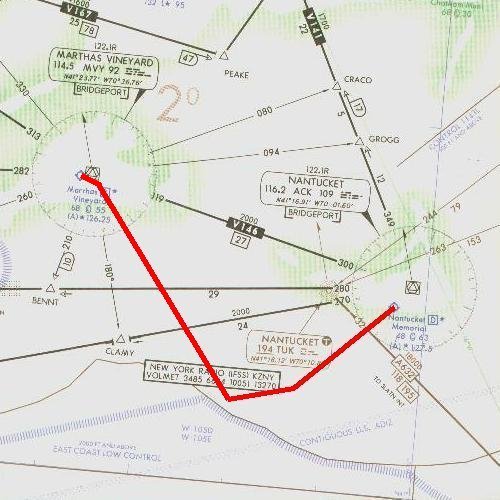
Marthas Vineyard airport, Vineyard Haven, Mass. to Nantucket Memorial airport, Nantucket, Mass. with a Back Course Localizer approach to Runway 6. Click the image to access the complete flight-information package.The flight route looks weird, doesn't it? Well, it was chosen for a reason. You just completed a flight with a procedure turn followed by the usual 45° intercept of the localizer inbound. As you have undoubtedly discovered by now, a 45° intercept is not all that simple. One either overshoots or undershoots when turning back onto final course, interspersed with the occasional nice roll-out on final to keep you trying harder. The only person who consistently does well intercepting at 45° is called an autopilot.
Your performance substantially improves, though, as the intercept angle is made smaller. It's amazing how much better an intercept is at 30°, for example, than 45°. ATC knows this as well as pilots, which is why they vector aircraft under radar control to a position for a 30° localizer intercept.
That is the intent of this unusual route from Marthas Vineyard to Nantucket, to put you on a flight path for a 30° localizer intercept, as if under radar control.
This final flight in the Localizer section is a nice relief from the previous flight. It is a simple departure from Marthas Vineyard, KMVY, with a turn at an intersection to put us on course to intercept the Back-Course Localizer to Nantucket's Runway 6, KACK. Click on the image above to download the flight-information package, mvy-ack.zip.
The zip-file includes the IFR chart, the approach plate for LOC BC Rwy 6 at Nantucket, and this text description of the flight.
We proceed south-bound from Marthas Vineyard airport after intercepting the 159° radial from Martha Vineyard's VOR. Fly 21 NM to an intersection, turn left to 091° to intercept Nantucket's Back-Course localizer to Runway 6, and land. That's it! Of course, we have to be constantly aware that we are flying the back course localizer and that the needle senses in the reverse: one must turn away from the needle to return to course.
As usual, do nothing until you have gone through the step-by-step details of the flight with this text and your charts. Only by doing this will you both understand the purpose of each step, but you will visualize them in your mind, a critical part of instrument flight.
NOTE: Fly the Instrument Approach portion with your Nav-2 Receiver for better needle visibility.
You will also use the DME during this approach.- Set the flight simulator weather conditions to 600 ft overcast, cloud tops at 10,000 ft., and two miles visibility. The wind is calm.
- Move the aircraft to Marthas Vineyard's Runway 15, airport KMVY, and retract the flaps to 0°.
- Tune the Nav-1 receiver to the Nantucket VOR, 116.2 MHz., ident ACK.
- Set the VOR-1 OBS to 249°.
- Tune the Nav-2 receiver to Marthas Vineyard VOR, 114.5 MHz., ident MVY.
- Set the VOR-2 OBS to 159°.
- Reset the timer to zero.
- Fly Nav-2. Takeoff from Runway 15, climbing out on a 135° heading. Be prepared to intercept the very near 159° radial of MVY.
- Intercept and track the MVY 159° radial southbound. The Nav-2 VOR should show a FROM flag. Ident MVY.
- ATC has cleared you to 5000 ft. Climb at 90 kts. and cruise at 110 kts.
- After the "off" flags disappear from the Nav-1 VOR, ident the VOR, ACK.
- Fly Nav-1. Keep the Nav-1 VOR in your scan. When that needle centers, turn left to a 091° heading.
- Begin your descent to 1700 ft.
- Slow to 75 kts.
- Retune your Nav-2 Radio to Nantucket's Localizer, 109.1 MHz.
- Set VOR-OBS-2 to 061° as reminder of approach heading.
- Ident the Localizer, I-ACK.
- Switch the DME to Nav-2.
- Keep track of the Nav-2 VOR for an intercept of Marthas Vineyard Localizer when the needle centers.
- Fly Nav-2. On intercept of the localizer, turn left to 061°.
- Drop one notch of flaps. You should be level at 1700 ft.
It's vital to stabilize the approach well before beginning your descent to the MDA.
- The FAF is 5.0 DME from Rwy.
- Stay on course with minor heading adjustments away from the needle. You are on the localizer Back Course.
- When the DME shows 5.0, at the FAF, descend to 380 ft.
- At 75 kts., 3 min., 36 secs. will elapse to cover the 4.5 NM from the FAF to the MAP.
- You should spot Runway 6 after 2 min. 30 secs. with two1 miles visibility.
- Continue your approach to Runway 6 and land normally.
- Not so bad, was it? It will probably be your best landing after doing the others. A back-course approach is a nice alternative to what might otherwise be a circling approach, nobody's favorite.
- Flight time: About 25 minutes.
Refly this short flight to hone the back-course skills further.
* * *
This is the end of the localizer approaches. You've flown five of them and your last ones should have been pretty good. With this experience behind you, go back and fly the five approaches one more time. You'll be pleased at how well you do.
The next piece in the ILS approach is flying the Glide Slope. Click the Flying the Glide Slope button below to get started.
Site best viewed at 600 × 800 resolution or higher.
© 1999 – 2002, Charles Wood.

